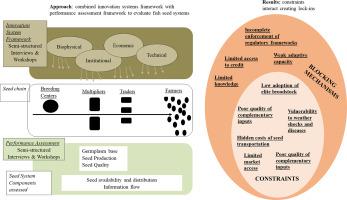Agricultural Systems ( IF 6.6 ) Pub Date : 2020-12-31 , DOI: 10.1016/j.agsy.2020.103042 Kelvin Mashisia Shikuku , Nhuong Tran , Olivier M. Joffre , Abu Hayat Md Saiful Islam , Benoy Kumar Barman , Shawquat Ali , Cristiano M. Rossignoli

|
Well-functioning fish seed systems are crucial for human nutrition and improved livelihoods. Yet fish seed systems have received considerably little attention in the diffusion process for genetically improved strains. This study examined how seed systems of genetically improved fish strains function, assessed constraints faced, and explored entry-points to increased diffusion. To address these objectives, the study combined the seed systems performance assessment framework with innovation systems thinking. Data came from participatory multi-stakeholder workshops and interviews with tilapia hatchery operators and grow-out farmers in Bangladesh. We found that tilapia seed production and dissemination was profitable and cost-effective indicating a business case for supply chain actors. However, there were several binding constraints including low adoption of elite broodstock, vulnerability to weather shocks and diseases, poor quality of complementary inputs, intermittent electricity supply, hidden costs of seed transportation, and limited market access. These constraints and their causes interacted, creating systemic lock-ins through blocking mechanisms related to incomplete enforcement of regulatory frameworks to control hatchery practices and quality of inputs; limited knowledge about broodstock management, quality seed production, and disease management; weak adaptive capacity to weather shocks; and limited access to credit. Projects, programs, and policies targeted at accelerating adoption of good quality fish seed should focus on the following important aspects. First, strengthening institutional capacity to monitor and enforce quality control. Second, increasing advocacy and knowledge transfer about benefits and sources of elite broodstock. Third, promoting adoption of better management practices by hatcheries and farmers including adaptation to weather shocks. Fourth, leveraging partnerships with local service providers as intermediaries. Fifth, using social networks for information diffusion among farmers.
中文翻译:

锁定遗传改良鱼种的传播
运转良好的鱼种系统对于人类营养和改善生计至关重要。然而,鱼种子系统在遗传改良菌株的扩散过程中很少受到关注。这项研究检查了遗传改良鱼品系的种子系统如何发挥功能,评估了面临的限制,并探索了增加扩散的切入点。为了实现这些目标,研究将种子系统绩效评估框架与创新系统思想相结合。数据来自参与性的多方利益相关者研讨会,以及对罗非鱼孵化场经营者和孟加拉国成年农民的采访。我们发现罗非鱼种子的生产和传播是有利可图且具有成本效益的,这为供应链参与者提供了业务案例。然而,存在一些约束性制约因素,包括低等亲鱼的采用率低,易受天气冲击和疾病侵害,补充投入品质量差,电力供应断断续续,种子运输的隐藏成本以及市场准入受限。这些制约因素及其原因相互作用,通过与监管框架执行不力有关的封闭机制来形成系统性锁定,以控制孵化场的做法和投入的质量;对亲鱼管理,优质种子生产和疾病管理的知识有限;对天气冲击的适应能力较弱;以及获得信贷的机会有限。旨在加速采用优质鱼籽的项目,计划和政策应集中在以下重要方面。第一,加强监督和执行质量控制的机构能力。其次,关于精英亲鱼的利益和来源的宣传和知识传播不断增加。第三,促进孵化场和农民采用更好的管理方法,包括适应天气冲击。第四,利用与本地服务提供商的中介关系。第五,利用社会网络在农民之间传播信息。



























 京公网安备 11010802027423号
京公网安备 11010802027423号